By Zina Hemady
Photographs by Norbert Schiller
The second half of trip, which followed the pumped up celebrations at Gondar, turned out to be the more fascinating part. Traveling by bus and plane we went on a whirlwind tour where we ascended to the high peaks of the Simien Mountains, home to one of the country’s most spectacular national parks, drove back down to the ancient city of Axum shrouded in legends about the Queen of Sheba and the Ark of the Covenant, and flew to Lalibela, an architectural wonder featuring medieval rock-hewn churches that are still one of Ethiopia’s most vibrant spiritual centers. Completing our historical and natural discoveries of the country were forays into the markets for some tough bargaining for crafts and antiques that are unique to this part of the world.

Our group hiking through a wooded area and then along a ridge in the Simien Mountains

A male Gelada monkey crosses the path of an unsuspecting tourist. Besides Gelada Monkeys the Simien Mountains are home to the Ethiopian Wolf and the Walia Ibex.
The journey from Gondar to the Simien Mountain National Park takes about 3 hours by bus. As we climbed, we encountered chanting and stick wielding youths celebrating yet another feast, that of Saint Michael. Like all observances, this one is an excuse for young men to stop vehicles asking for money to indulge themselves in honey wine, a highly potent and cheap local alcoholic beverage. The youth are mostly harmless, but they can become rowdy after a few drinks. After picking up two rangers at the park entrance, we drove to an altitude of 3,260 meters (10,695 feet) to a viewpost from where we could admire the powerful peaks and deep gullies of this mountain chain. The Simien massif, one of Africa’s principle mountain ranges, was formed as a result of volcanic eruptions 40 million years ago explaining its dramatic landscape which includes the 4,533 meter (14,872 feet) high Ras Dashen, the tallest peak in Ethiopia and Africa’s fourth highest.
Besides the scenery, the mountains offer a rich mix of flora and fauna. The vegetation includes various species of acacia trees, the endemic Abyssinian rose with its cream colored flower, and the Hypericum revolutum shrub with its vivid yellow flower. In addition, the Simiens are home to three endemic species of mammals, the Ethiopian wolf, the walia Ibex, and the Gelada monkeys. The first two animals are difficult to spot while the third is surprisingly accessible and sociable. After a picnic lunch, we headed to the area where the Gelada gather to forage for grasses in the dry season. As they busily went about digging and pulling out roots, we sat among them snapping pictures and taking videos. The handsome males, with their striking blond manes and heart-shaped red chest patches, posed for tourists uninhibitedly.

A male Gelada monkey poses for the camera while digging up roots. Gelada monkeys and tourists mingle.
On the logistical side, the trip had gone relatively well with some grumbling about the water pressure in the shower and the mediocre food. However, we faced a crisis at the mountain lodge when the singles in the group, mostly seniors, were booked in rooms with outdoor bathrooms and showers. In order to defuse the situation, our nimble guide Hailom offered to take the disgruntled guests back to Gondar which now had many availabilities. As a result of this hitch, we learned that hotel reservations in Ethiopia were negotiable meaning that you stand to be downgraded if the hotel management is pressed for rooms to accommodate more important guests or larger groups.
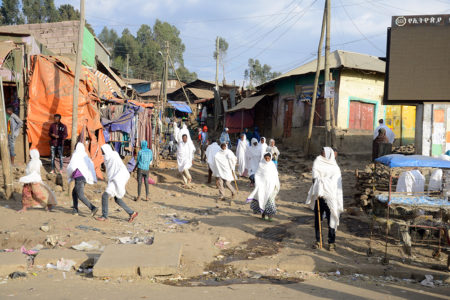
Villagers going about their business in the town of Debark at the entrance of Simien Mountains National Park
The following day we regrouped and embarked on the 600 km (373 mile) route to the ancient city of Axum in the heart of the Tigray region. As we descended down a winding and dusty unpaved road, the landscape became more desolate and temperatures considerably warmer. Every time we hit a bump or a pothole, the guide jokingly compared the effect to an “African massage,” but it was one with a powerful jolt. It was a relief when we finally joined the asphalted road for the rest of the drive to Axum. Since I had read the reviews, I wasn’t surprised by the standard of the Yeha Hotel, which has a charming hilltop location but a shabby interior accentuated by a heavy and dingy red carpet. The rest of the group, however, had lost patience with accommodation disasters, so Hailom had to play musical rooms to minimize the damage. But in such situations, shopping never fails to save the day. So far, we had only purchased a few souvenirs as we were told to reserve the big moment for Axum, and it was well worth it. The city has a few shops that specialize in Ethiopian handicrafts and old artefacts. The crafts include religious paintings, silver jewelry, cotton cloths, and traditional baskets. Among the genuine antiques are the Axumite coins featuring portraits of ancient kings which are found by farmers and sold illegally to tourists. When making purchases, the rule of thumb is to keep bargaining until the seller agrees to a 50 percent markdown.
Axum and the region around it are steeped in history, but much of it remains based on oral tradition. While the city’s association with the 11th century B.C. reign of the Queen of Sheba is mostly speculative, what is certain is that as early as the 400 century B.C. a major civilization started to rise in this area reaching its peak between the 3rd and 6th centuries. For 1,000 years Axum was a powerful trading empire that dominated sea exchanges between Africa and Asia before collapsing suddenly and falling into oblivion until the 20th century.

The giant stele or obelisk structures were erected in Axum as a show of power by the royal families. The largest, the Great Stele, fell to the ground and broke apart when it was being erected.
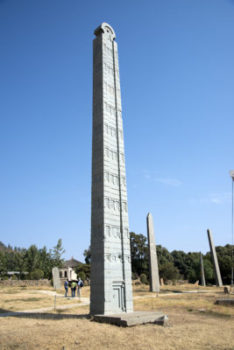
Giant obelisks stand in the Northern Stele Field.
One of the greatest remaining symbols of this civilization are the stele or obelisk-like structures erected as a show of the royal families’ power. The most impressive, located at the Northern Stele Field, are considered ancient engineering wonders. The granite blocks used to build the structures were excavated at a nearby quarry, dragged to this site, and elevated as single pieces of stone. Many of these modern looking pillars, often compared to high rises, have intricate designs including windows and doors carved into their sides. Of the 66 stelae in this location, the three largest are the most spectacular. The Great Stele, which lies in pieces on the ground, is the largest weighing 515 tons and measuring 33m (108 feet). It is believed to have fallen while it was being lifted due to its massive size, but local legend claims that it was knocked down by Gudith, the Jewish warrior queen who destroyed much of Axum and its surroundings in the 10th century. Nearby stands the Rome Stele, the second highest, which collapsed around the 8th century when tomb diggers destabilized it, but was reassembled in Rome after Mussolini ordered it shipped to the Italian capital in 1937. The stele was returned to Axum in 2005. The third tallest, credited to King Ezana the first Axumite king to convert to Christianity, is the only one of this size that has never collapsed although it now stands off center and is supported by a metal pole.
Just west of the town center is the Queen of Sheba’s Palace, also referred to as Dongar. Oral tradition claims that Queen Makeda, as she is locally known, ruled over Ethiopia and Yemen from her capital near present day Axum. Although there is little archeological evidence to link the site at Dongar with Sheba’s reign, recent discoveries have raised speculations that her palace may lie underneath the current ruins. Regardless of its origin, the palace is said to have been the most impressive in Axum boasting over 50 rooms and a complex drainage system.

Queen of Sheba’s palace outside Axum from where she ruled over both Yemen and Ethiopia
Most Ethiopians believe firmly in the ancient legends that make up their collective history, namely the one that explains how the Ark of the Covenant ended up in Axum. According to this narrative, Queen Makeda traveled to Jerusalem to meet King Solomon after hearing about his unrivaled wisdom. After a sumptuous visit, and a seeming a love affair, the queen returned to her kingdom giving birth to a son along the way. When Menelik I came of age, he went to visit his father who tried to persuade him to stay in Jerusalem. When Solomon’s efforts failed, he sent his son back to Ethiopia with a group of noblemen’s sons. Before leaving, one of the young men in the traveling party stole the Ark of the Covenant. When Solomon discovered the theft, he ordered his people to keep it a secret an to replace the original with a copy.
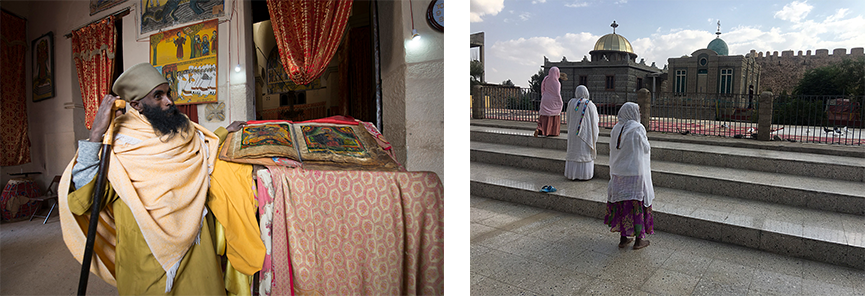
A priest inside the 17th century Saint Mary of Zion church closest to the fortified building that allegedly houses the Ark of the Covenant. Women are not allowed to enter the church but can pray towards it from a short distance. Phot. (R) Zina Hemady
In the 4th century, King Ezana built Africa’s first Christian church, Saint Mary of Zion, where the Tabot was stored. The original church was destroyed allegedly by Queen Gudith but some historians attribute its demolition to Ahmad Gragn’s invading Moslem armies in the 16th century. The one that stands at the site now was built by Emperor Fasiladas in the 17th century and is adjacent to a chapel where the Tabot is said to be hidden. Except for the hand-picked guardian, no one is allowed to come near the heavily guarded chapel. Women are barred from entering the old church due their gender’s association with Gudith the heretic. They are only allowed to enter the modern featureless version which also stands on the compound, a place of great religious significance to Ethiopians.

Lailibela’s churches are carved into soft volcanic tuft. As the elements have started to take their toll on these ancient wonders, UNESCO funded a renovation project which includes the erection of a a roof-like structure to protect many of these churches.

The Jordan River in Lalibela
Our next destination, Lalibela, is as dreamlike as its name suggest. Home to Ethiopia’s most impressive rock-hewn churches, the town is a magnet for local pilgrims and tourists who converge here to express their deep devotion or silently admire the complex of 13 underground churches, all credited the quixotic ruler who gave the city its name. Lalibela, the 6th and most famous Zagwe ruler, is said to have built the churches based on a vision he had as a child while he was in a coma after being poisoned by his brother. Another legend claims that the king wanted to build a Jerusalem in Africa to save pilgrims the trouble of making the long and dangerous journey to the sacred city. That explains the abundance of sites with Biblical names such as the Jordan River, a moss-covered stream separating Lalibela’s two clusters of churches, the northern group and southern group. As with the rest of Ethiopia’s history, legends abound about how and when these mighty structures were built. The most incredible tale is that Lalibela was responsible for carving out the churches overnight, with heavenly intervention. Another more realistic version asserts that the churches were built during the king’s 1181- 1221 AD reign over a period of 23 years. Even this account is questioned by experts who have detected a wide variety of architectural styles among the churches leading them to believe that many date back to the pagan or Axumite period when they served as forts or palaces.

The twin church of Bet Gabriel-Rafael is surrounded by a trench that looks like a moat leading to the assumption that it had previously served as a palace.
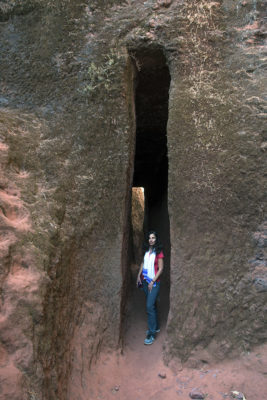
A dark passageway connecting churches
After a short plane ride from Axum, we arrived in Lalibela around noon. We checked into the Cliff Edge Hotel, which much to our relief, was clean and bright offering a spectacular view of the surrounding valleys and ridges. As Lalibela is perched at about 2,600 meters (8,500 ft) the crisp air felt refreshing after Axum’s warmer and more humid weather. The outdoor lunch at the Old Abyssnia Lodge, a charming boutique hotel with only three bungalows for guests, was a treat of wholesome stews and vegetarian dishes. Once recharged, we went on a tour of the northern cluster, which is held in higher esteem than its neighbor. Like all of Lalibela’s rock-hewn churches, the churches in this cluster were carved into the mountainside’s soft volcanic tuft but what distinguishes them is that they are either entirely or mostly monolithic, meaning that they consist of single blocks of stone standing free on four or three sides from the surrounding rock. The largest is Bet Medhane Alem, a rectangular structure sprawling over 800 square meters (8611 square feet) and surrounded by 34 columns giving it the appearance of a Greek temple. One of its main attractions is that it houses the 7 kg (15 lb) solid gold Lalibela cross which the priest brings out on special occasions. A tunnel connects Bet Medhane Alem with a courtyard housing three smaller churches. Bet Maryam, dedicated to the Virgin, is the largest and most impressive. Its ceilings are covered with exquisite ancient frescos while its columns display fine carvings including one of the Star of David and the original Lalibela cross. A tall column covered in white fabric is said to be inscribed in ancient Greek and Ge’ez with the story of life from the beginning until the very end. Of the two adjacent churches, Bet Meskel is tiny and unremarkable, while Bet Danagel or “House of the Virgins,” dedicated to the 50 or so maiden nuns allegedly killed by the Romans in present-day Turkey, is charming. The twin church of Bet Michael and Bet Golgotha, named after the Jerusalem hill where Jesus was crucified, features an inner chamber with seven life-size carvings of saints, giving it a tomb-like atmosphere. It also includes the Selassie church, the alleged burial site of King Lalibela. The tour ended at Bet Giyorgis, which sits on a hilltop set apart from the others offering a magnificent view of the surrounding landscape. Built completely underground in the form of a perfectly symmetrical cross, the church dedicated to Saint George is the undisputed masterpiece here.

Ethiopian pilgrims visit Abba Libanos, a small church said to have served as King Lalibela’s private chapel.
The following day we visited the southern cluster and two monasteries, Asheton Maryam and Yemrehanna Christos. Although less impressive in size, the churches in this group have more intriguing exteriors. The twin church of Bet Gabriel-Rafael is surrounded by a trench that looks like a moat leading to the assumption that it had previously served as a palace. The façade is decorated with typical Axumite niches but the interior of the church itself is small and plain. From there we navigated an underground maze of tunnels, sometimes in pitch darkness which locals say represents the journey through hell, to reach Bet Mercorios. The church, dedicated to a saint killed by Romans, is believed to have served as a jail as some shackles were discovered at the site. It houses a restored painting of Mercorios on a black horse slaying Roman Emperor Julian and a faded fresco allegedly of the three wise men. Another tunnel leads to a courtyard housing Bet Emmanuel, the only fully monolithic church in this cluster. Finely built in typical Axumite style, the church is thought to have been the royal family’s private chapel. The cells in the walls outside are graves of pilgrims and currently serve as sleeping quarters for monks. The final stop was at Abba Libanos, a small church said to have served as King Lalibela’s private chapel.

The view of Lalibela and surrounding countryside from the 3200 metes high Asheton Maryam monastery
Asheton Maryam is perched at an altitude of 3,200 meters (10,498 ft) atop the mountain of Abune Yosef and offers a spectacular view of Lalibela and its surroundings. The 30 minute walk up to the monastery, often along a narrow ridge, is a delightful hike in a setting evoking spirituality. The church itself is a far cry from the monuments we had previously visited in terms of its poor construction, but it does house some rare manuscripts and ancient crosses. The last and most unusual site was Yemrehanna Christos, a monastery built about 80 years before the churches of Lalibela. Set inside a deep dark cave about 45 km (28 miles) north of town, the monastery is surrounded by a luscious landscape which includes juniper and wild olive trees. What distinguishes this church from the others is that it was built rather than excavated with a façade displaying layers of dark wood and light stone. The cruciform window carvings and ceiling hexagonal etchings are proof of exceptional craftsmanship. Adding to the spooky cavernous atmosphere are the bones of the more than 10,000 workers and pilgrims who are said to have traveled here from faraway lands to die.
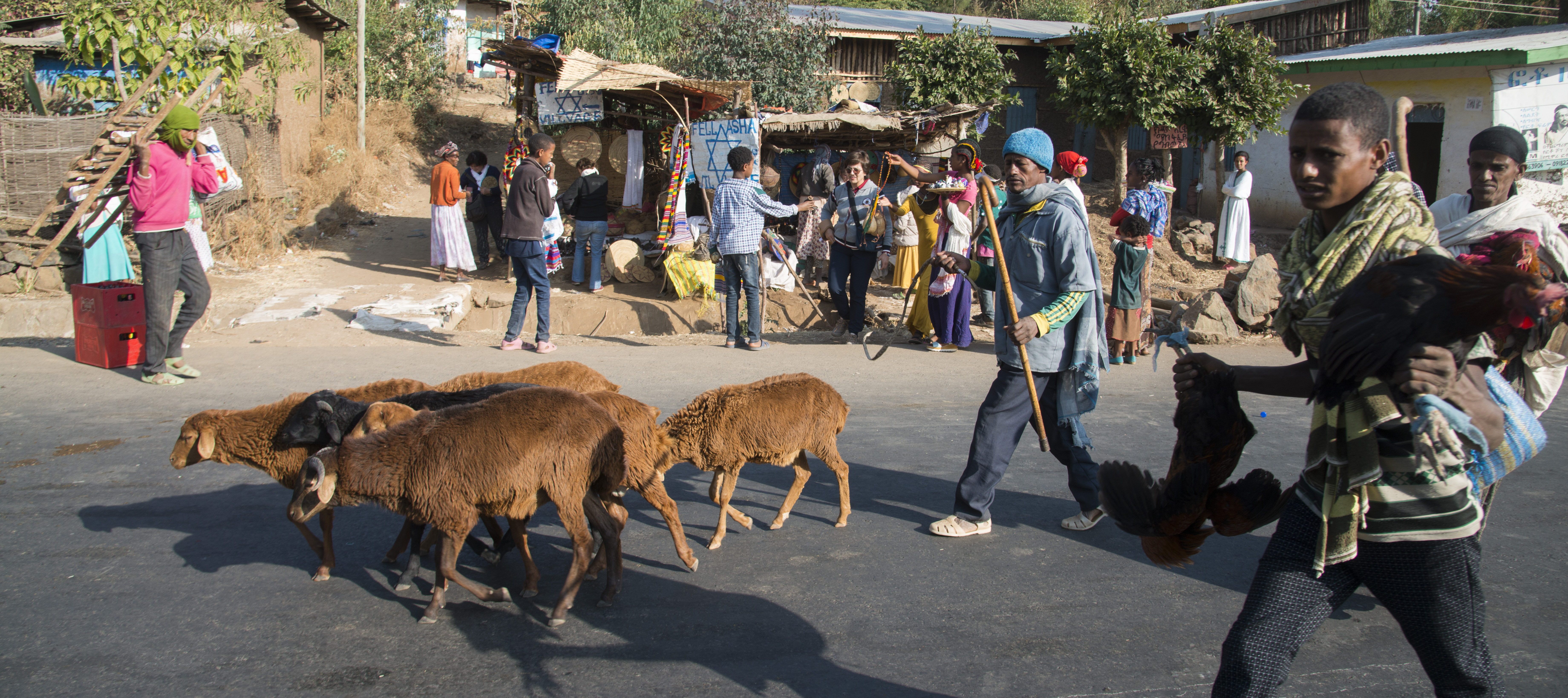
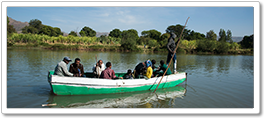


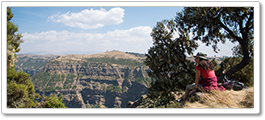
Massacre at Saint Mary of Zion Church in Axum, Ethiopia - NEGATIVE COLORS
[…] The story in the link below is one of two articles describing northern Ethiopia, including Axum and the Church of Saint Mary of Zion, during more peaceful times. Hoping that sanity will prevail again in this beautiful land of many legends. Ethiopia: Land of Many Legends and Dazzling Beauty (Part II) […]